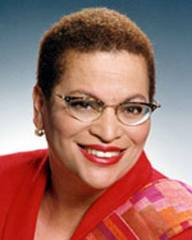
By Julianne Malveaux
NNPA Columnist
The racial differential in the poverty rate is staggering. Last time I checked, about 12 percent people in the United States, one in eight people are poor. Depending on race and ethnicity, however, poverty is differently experienced. Fewer than one in 10 Whites are poor; more than one in four African Americans and Latinos are poor.
Differences in occupation, income, employment and education are considered the main reasons for poverty, with current and past discrimination playing a role in educational, employment and occupational attainment. We see the discrimination when we consider that African American women with a doctoral degree have median earnings of about $1,000 a week, compared to about $1,200 a week for Black men and White women, and $1,600 a week for White men. White men earn 60 percent more than African American women, and a third more than Black men and White women.
It would not take much to recite the differences, by race, or education, unemployment, earnings and occupation. The recurrent question in reviewing the data is: What are we going to do? It makes no sense to just recite the data and then wring our hands as if nothing can be done. The three steps in social change are organization (especially protest), which leads to legislation (with pressure) and litigation (when legislation is not implemented).
Often laws preventing discrimination have been passed but not adhered to, forcing litigation to get offenders to do the right thing. Of course, it takes more than a minute. It takes people who are committed for the long run. “The arc of the moral universe is long, but it bends toward justice,” Dr. Martin Luther King said in 1964.
Carter Godwin Woodson understood the long arc when he founded the Journal of Negro History and the Association for the Study of Negro Life and History in 1915. The organization and the journal have changed their names to reflect the nomenclature of these times, and they are now called The Journal of African American History and the Association for the Study of Negro Life and History. Both the organization and the journal have now existed for 100 years which is perhaps why ASALH chose “A Century of Black Lives, History and Culture” as its 2015 theme. (ASALH choose a Black History Month theme each year). This year, their focus on the long arc of African American life in our nation and asserts that “this transformation is the result of effort, not chance.”
Carter G. Woodson made many choices that led to his education and to the creativity and brilliance that motivated him to uplift Black History through Negro History Week, now Black History Month. Woodson was the son of former slaves, and a family that was large and poor. He worked as a miner in West Virginia, and attended school just a few months a year. At 20, he started high school and by 28 he had earned his bachelor’s degree. He was only the second African American to earn a Ph.D. from Harvard (W.E.B DuBois was the first in 1895). He was a member of the Howard University faculty and was later a dean.
He wrote, “If you can control a man’s thinking you do not have to worry about his action. When you determine what a man shall think you do not have to concern yourself about what he will do. If you make a man feel that he is inferior, you do not have to compel him to accept an inferior status, for he will seek it himself. If you make a man think that he is justly an outcast, you do not have to order him to the back door. He will go without being told; and if there is no back door, his very nature will demand one.”
In other words, poverty can be the reality of living, but it doesn’t have to be a state of mind. Many are trapped in poverty because that may be all they know, and because protest, legislation, and litigation have not provided a passage out of poverty. No one provided a passage out of poverty for Woodson. He worked as a miner to earn a living, and he transcended his status as a miner to make a life of embracing his people and our history. He wrote about the ways that our thinking could oppress us as much as living conditions can. He is a role model and example for African Americans today because, motivated by a desire to be educated, he fought his way out of poverty. There is a difference between thinking you can live like Carter G. Woodson, and thinking that you can’t. (CHECK OUT www.ASALH.org for more information on Carter G. Woodson and his organization.)




